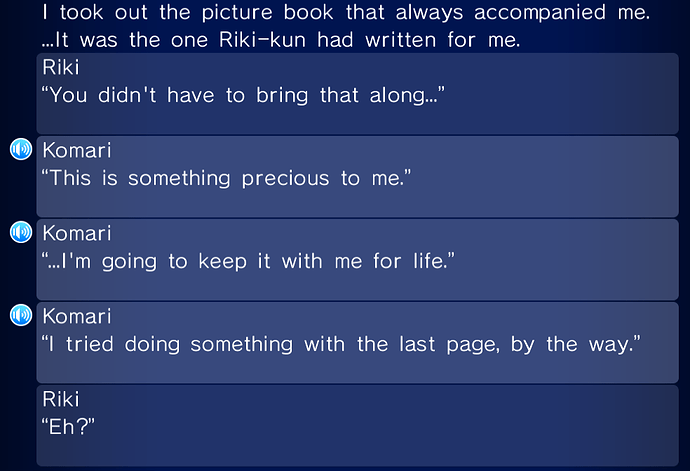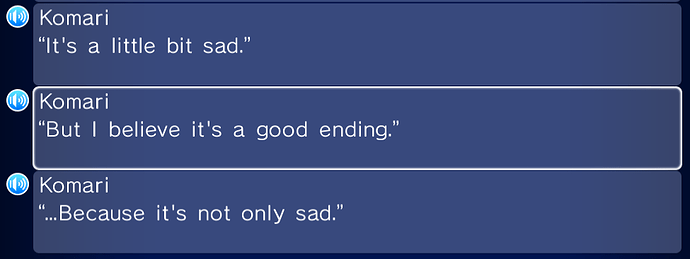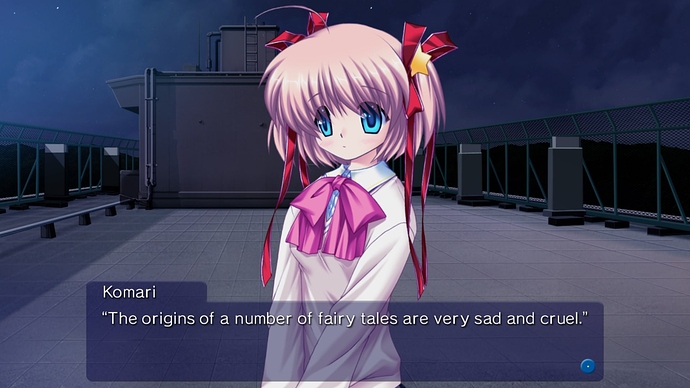So Riki and Komari are set on opposite sides of the same spectrum, and slowly pull each other to the middle. Beautiful.  Though examining Komari’s quote, I wonder what exactly compels her to say that. If she doesn’t acknowledge the bad things in life, does she simply want Riki to be happier? To ignore them the way she does? I also wonder what effect Riki’s negativity had on Komari. I don’t think he ever soured her mood once, especially since she seemed so enamored with him.
Though examining Komari’s quote, I wonder what exactly compels her to say that. If she doesn’t acknowledge the bad things in life, does she simply want Riki to be happier? To ignore them the way she does? I also wonder what effect Riki’s negativity had on Komari. I don’t think he ever soured her mood once, especially since she seemed so enamored with him.
Waaaah finally got to reread a route for LB! Bookclub! I’ll check out Mio’s later; I just realllyyyyy need to talk about Komari route, and why I think it actually subverts certain genre conventions despite being a pretty standard Key story.
Before that, I want to do a little gimmick, which I’m in this particular phase of wanting to do so, for all of my heroine route reflections for this Bookclub: I think of a Classical music piece that best represents a heroine or her route. My knowledge of the genre is very limited, so I’ll very likely be stuck with the more mainstream stuff.
Anyway, it was easy to come up for Komari, only because there’s a very popular Theme and Variations piece that suits her down to its (English) title: Twinkle, Twinkle Little Star, KV 265/300e. The piece is based on a children’s song, but each variation is an interesting take on its otherwise simple main theme. I especially the 8th and the 11th variations: the former is transposed to a minor key, giving it a dark and gloomy color, while 11th is melancholic but hopeful. Its composer, Mozart, often gave off the impression of being genki and frenetic in his pieces, but he definitely had sentimental moments – they’re just rare and not very well known. These fit Komari quite well.
Now, on to the route itself!~
The thing about Komari route is that it’s childish, intentionally so. This is best exemplified by its use of children’s stories as its central motif, and Komari herself is among the most overtly childish characters in the game. Not necessarily a bad thing; she brings a lot of fun to the story.
But the drama is really where I’m getting at. True, Komari’s story takes a very conventional Key story of loss and healing, and plays it pretty straight. Except for one thing. Key routes of this type often highlighted the importance of finding happiness in spite of sad things, and while that’s still very well a part of Komari route, it starts turning into special by embracing another different angle, one that I think a lot of these stories tend to gloss over: the need to accept the fact that sad things do happen, and it’s okay to be sad. This is best highlighted by some of the last few lines of the route:
The thing is, Komari’s problem has been that she’s been attempting to forget sad things, thinking she should only see happy things. Only when she had accepted that death, which has been causing her sadness, do exist has she been only able to move forward. (Important to note that it takes more than just being made aware of that fact to be able to move forward. She needs someone who can support her. Actually, a support network is much better, and I like that the anime had Rin take an active role in her story, though I didn’t really like the execution of their Komari arc in general.)
On a different note, I like the little touch on the nature of Takuya’s illness; I think it’s actually based on something in real life. It could have been just a random Coughing Blood Disease, but then you have Kojirou (he’s the best btw) saying this:
He coughed up blood at some point in his life. And so was his brother. And so was Takuya. I did the math.
Well dang.
Anyway (and my thoughts are rather jumbled; I’m so sorry  ), I think Komari Route generally suffers from being a little too on-the-nose in its thematic exploration, but I like that its takes the standard Key drama to a more interesting angle, and its straightforwardness can be quite charming, too. 4.25/5
), I think Komari Route generally suffers from being a little too on-the-nose in its thematic exploration, but I like that its takes the standard Key drama to a more interesting angle, and its straightforwardness can be quite charming, too. 4.25/5
Do you guys have any Key points you would like us to discuss in the podcast? Make sure you put a question in bold if so!
I still feel from a narrative standpoint there isn’t any discussion around this. There is too much assumption on Riki’s part which doesn’t come across as a believable response for me. Also, paired with her seeing anything dead seems a bit of a stretch. I think actually witnessing death would be more of an effective response for me. Another reason I feel this story reaches too far.
I would ask podcast ppls: If they found this route was trying too hard? How would you compare it among other key routes? And what were the high and low points for them of this route?
Ok, I just wanna be sure we’re all on the same page. Is everyone here aware that Komari is suffering from an hereditary mental affliction that makes her recall trauma with the same, or even greater intensity as when it originally happened when triggered?
This is not the story about a girl remembering something sad and everyone’s being dramatic over how sad she is. Look at those eyes. She’s breaking inside. Many people tried helping her but failed.
We could still talk about… yea, let’s do that. Which parts of Komari’s broken state do you think are part of her “Flashback Syndrome” and which are self-induced?
For example, it could be argued that Komari seeing Riki as her “onii-chan”, may not be part of the mental affliction, but her own coping mechanism she puts on top of it. I personally don’t believe that because it would mean that not only her sickness, but also her coping mechanism is coincidentally the exact same one as that of Kojirou’s wife.
I could argue that most or all of her broken state are self-induced, based on when she goes into it. It seems to pop frequently, but stays for only a moment or two; she seems to snap out of it when Riki tries something to help her. Not sure if the VN is just using reusing sprites or not. You could see it as a desperately innocent girl trying to create a “happy ending” through her own willpower, calling Riki onii-chan to help give her the strength needed to keep up this illusion.
Her situation did seemed to me like a case of PTSD, which is known to have possible genetic cause, and I think it’s what Tonokawa is getting across about her. (I might have fell short of articulating adequately Komari’s circumstance; thanks for bringing this up.)
A blog post once linked by someone here in Kaza better explained it, but I’m still trying to find it. From what I remember from it, the thing that’s happening to her is that she’s attempting to cope, but because no one was able to give her proper help, her coping mechanisms were turning out to be counterproductive without anyone being able to address it. It’s called something like negative coping, and stuff like repression of memories and thinking that someone he likes is the brother she lost fall in that category.
I’d have to say that the part about calling Riki “onii-chan” was her own coping mechanism, not a part of her mental affliction, even though it was the same for kojirou’s wife. A predisposition for that kind of coping mechanism might be hereditary in the family.
The way this makes it distinct from being part of her “flashback syndrome”, and the reason I think they’re different, is that once Riki really put his foot down and started insisting that he wasn’t her “onii-chan”, she gave in surprisingly quickly. That, and the fact that resolving that point alone made her feel even worse, rather being progress, makes me think it was a self-imposed coping mechanism rather than part of her actual mental affliction.
One fairy tale discussion, with lots of symbolism on the side, coming right up!
Among other things, fairy tales are a way of communication to Komari. She’s writing fairy tales herself, Takuya spent a lot of time reading and writing some for her, and Riki could finally get through to her and cure her from her affliction by ways of a fairy tale (and a hug. That stuff’s magical).
Komari talks a lot about fairy tales during the shooting star viewing. She doesn’t like sad fairy tales. The fact that many fairy tales as we know them today have been rewritten and given a more pleasant ending shows that many people feel the same, she concludes. Even “A Dog of Flanders” supposedly got an adaption with a happy ending. She describes it as “helping” or “saving” the sad story. What Riki did for Komari in the end was the same, only that he didn’t hide the sad parts.
Komari’s broken state can be described as a failed attempt at rewriting her story. But while the sad things could be forgotten, they could never be erased and made her suffer all the more.
I’ll focus on a certain fairy tale that’s particularly significant for Komari: The Little Match Girl.
To put it short, it’s story about a poor girl freezing to the death on the street in the night of New Year’s Eve while seeing a shooting star and a series of pleasant delusions, including the reunion with her dear late grandmother.
(The tale is rather short, so you should give it a quick read. There’s bound to be more connections to be found between the tale and Komari’s route than what I’m adressing here!)
It’s from this fairy tale that Komari has learned the concept of “death”. She started associating shooting stars with it. Thanks to Takuya, she doesn’t hate them, but she never forgot the association. She does associate them with one other thing: wishes.
In the epilogue, Komari presents Riki’s/Takuya’s fairy tale, the last page of which she had drawn herself. The fairy tale where she is the main character. On that page, she disappears. With this, and her commentary that “it’s not only sad,” Komari shows that she… well, what exactly? Do you think it’s a sad bittersweet thing like what @BlackHayate02 suspects?
To put it in the sappiest way possible, I think the final page represents Komari’s eventual death or disappearance from Riki’s life. Yes, it is sad one day they will be apart, but now that Komari can face reality with Riki, they can go on to make many memories together, helping each other up when they fall. Komari no longer fears what may happen, what reality may present, because she has Riki and her friends to help her, and she can spread the spiral of happiness even further, immortalizing herself in Riki’s heart and world.
A bit of analysis on how the Little Match Girl connects to Komari
First, let’s begin with summarizing the Little Match Girl.
Summary
A poor girl was selling matches on the street on new year’s eve night.
She pleaded to people to buy her matches but no one shared a glance at her.
Soon, everyone on the street disappeared (went home) and her feet were frozen from walking on the snow bare foot ( she had shoes but they were removed ).
The girl sat on the corner of an alley hoping to avoid the snow. She tried to keep herself warm so lit one of her matches.
It was then a furnace appeared in front of her. To keep herself from freezing, she took a step towards the furnace.
The fire suddenly disappeared along with the furnace. The cold weather attacked her again from all sides.
She lit another match and this time, a table with an amazing feast appeared. The goose roast ( it was something she wanted to eat for a long time) seemed to be walking towards her.
Once again as she stretched her hands, the fire disappeared and so did the feast and the table.
Lighting another match, she saw a Christmas tree full of candles. However, as she went closer to the tree, the match died out and all the candles flew up to the sky (no they didn’t disappear this time) .
The candles turned into stars to fill the night sky. It was then a shooting star passed by. The girl thought, “Oh someone is dying” as her late grandmother told her that when a comet falls, someone is dying and going up to heaven.
The girl lit another match and saw her grandmother. She was just standing there, smiling.
The girl knowing that her grandmother would too disappear if the candle dies out, she lit all her remaining candles. It was much warmer than before and her grandmother’s silhouette turned much clearer. In order not to lose her grandmother, she jumped towards her silhouette.
The girl’s grandmother hugged her tightly. It was no longer cold nor hungry. They both ascended to heaven surrounded by a warm light.
I personally felt that Komari’s broken state is the story of the Little Match Girl. Here are some reasons why I think that :
- The repeated delusions that kept disappearing can be compared to Komari’s cycle of struggle when she had to come to terms that Takuya is dead.
- Lighting another match each time can be seen as an equal to Komari choosing a substitute for her “Onii chan” each time since both the actions are coping mechanisms to avoid the sad reality.
- They both chose to avoid reality each time it came to bite them back and instead chose a delusion in which nothing sad happens.
- The ending of the Little Match Girl is the bad end to Komari’s route. In the ending of the book, the girl chooses to avoid reality forever. In the bad end of Komari’s route, Riki states that Riki and Komari are separated from the outside world forever.
It was then, Riki came to rewrite Komari’s story once and for all. The main reason that the Little Match Girl died was because no one was there to help her. When Riki told Komari that he will always be there for her (as Riki Naoe not as Onii chan). Komari felt that she could be able to accept sad things if she were with Riki.
In other words, the Little Match Girl found a reason to live in the world which is a mixture of happiness and sadness.
Or at least I felt that way. What do you guys think?
In the story of the Little Match Girl, the girl lights all of her matches at once to keep the vision of her loving grandmother within alive as much as she can. I want to argue that Komari regressing into her broken state after seeing the dead cat is analogous to that part of the story, but this time it’s a cry for help, for Riki to come and help her. She wants him to be like the grandmother in the story, who I think represents both Takuya in the past and Riki in the present.
In the story, the girl dies with a smile on her face, as others pass her by and wonder what happened; I think this mirrors the ending of the route, where in Komari’s fairytale ends with her disappearing, telling Riki it’s not all sad because she still felt the warmth of his and Takuya’s love before she inevitably left Riki’s life. Of course, the end of the fairytale representing the bad end is just as valid too, but I think it’s open ended enough to where you can argue that the end of the fairytale can match both ends of the route.
A post was merged into an existing topic: Little Busters Memes
I have a thought. In komari’s route, it is always said that komari’s eyes see the better (good) in things and at the end she wishes that riki could also see it.
Quote on quote ‘May your eyes see better, just a little better’.
In Mio’s route we are presented with ’ good intentions’ and ‘bad intentions’ choice two times. At the first time it does not affect Riki much but the second choice screws up Riki if he fails to see the good in Midori (bad intentions).
Did komari tried to guide Riki like this?.
Not a super long post this time, but as I close even further on the Secrets this world holds I’m seeing more and more Shinto symbolism, especially tied to Komari 'Kami’kita.
There are numerous points in the story where she is engaging birds and flowers and such, she is strongly associated with nature. Her association with the Sun could also be tied directly to the Sun goddess Amaterasu. One of the most commonly known stories about Amaterasu involves the goddess shutting herself in a cave, depriving the world of her sunlight. Eventually she is brought forth again by many attempts by the other gods to get her attention and draw her back to the outside world. One such attempt involved the decoration of a Sakaki tree with ‘fine white clothes and a mirror at its center.’ I believe this parallels Komari’s detachment and ‘withdrawal’ into her own memories before Riki shows her what she is doing with the book that serves as a parable to her life, himself being represented by ‘the white’ (in Shinto, white represents purity, similar to how in Western cultures it’s represented by a blank slate). The brother of Amaterasu is Susanoo, god of storms. Susanoo causes all sorts of trouble for his sister, and once again this parallels the use storms in the cat scene and in the Bad End.
In Shinto, Red is also for protection against illness/sadness, in the scene where Komari breaks down in Riki’s room she takes off her red hair ribbons, symbolic of the traumatic state she’s in. As a side note, I don’t think it’s at all a coincidence that both of the Natsume siblings have a bright red colour for their names in the batting practice screen. It’s also worth noting that the orange colour we see in the title screen and in flashbacks (a colour here strongly associated with memory) in Shintoism is the colour of the arches one passes through to enter their shrines, supposed to prepare you for entrance.
Extra point: Oh, and Komari’s life-philosophy the ‘Spiral of Happiness’ fits perfectly within this, it describes the relationship between Kami (who help and guide humans) and humans (who give offerings to the Kami) and how they interact with one another. Kami and humans live in a symbiotic relationship in a sense, and if one side stopped their giving then the other side would wither, it’s a mutual bond of happiness. It’s a perfectly natural thing. Wholesome even, like Belgian waffles.
So basically what I’m trying to say is that there’s a lot of Shinto stuff going on, and Komari is Amaterasu. Any questions? 
F U E ?
My opinions on Komari tend to either be agreed with or disagreed with on a 100% point. I’ll just get it out of the way first. I don’t like her. She’s not the type of character I’m a big fan of. Every shoujo has a childish moe character, but I feel that it’s a bit overdone with Komari, especially in the way that she talks.
However, I respect what she does for the story and believe that her route is one of the better ones in the entire game. Hats off to one of the more realistic routes in the game. One of my favorite parts about the Komari route is that realism itself. It makes it easy to follow the entire story from Point A to Point B, and therefore requires minimal effort to get sufficiently wrapped up in the events emotionally. Komari, for me, is a lot like Rin from Katawa Shoujo. Whereas I felt that Rin in the common route was great and Rin in her own route was terrible, it’s the opposite for Komari. I heavily dislike Komari in the common route, but the more I got into Komari’s route, the more I liked her.
Komari’s route also holds the honors for one of the moments Little Busters has made me cry, specifically when Little Melody kicks in when Riki is reading her the book he made. I also really really loved the scene where Komari breaks down after seeing the dead cat, I think it was executed absolutely perfectly. The one detail of the route I had to take issue with was that Kojirou’s wife, who just so happened to suffer from the same emotional triggers as Komari Kamikita, just so happened to also be named Komari Kamikita. I felt like they could have easily thought up several different explanations that weren’t your typical anime-coincidence. But it didn’t detract from the route at all.
Another interesting thing I noticed is that, Refrain spoilers ahead, Choosing the bad end to the route essentially makes Riki do the same thing Kengo wants to do, and just let things continue as they are, so long as the people in question remain happy. I thought it was a very interesting comparison.
All in all, I really don’t have all that much to say about the route since most of the things about it are very straightforward. I may not like Komari that much, but her route is one of the absolute best in the game.
Authors don’t make coincidences happen just to point out how big a coincidence it was, unless it’s for comedic effect. Giving two characters the same name is a stylistic device, much like metaphors. It’s to further accentuate that Kojirou is the bad end Riki and his wife was the bad end Komari, displaying what would happen if Riki takes the easier way out. A side character exists in order to support the main characters and the story itself. They don’t exist in order to cement their own individuality, but to contribute to the plot.
I can’t help but point out that judging Key routes by realism is rather pointless. We all know that Key writers usually trade off realism for a greater emotional impact - and it pays out. Sometimes, they add supernatural elements to an otherwise realistic setting to create ‘magical’ moments with a special mood. Sometimes, they use it to create even more emotinal developments. For some stories, they don’t use any supernatural elements at all, but that doesn’t make them automatically better or worse.
Similarly, judging stories by one’s personal capability of instantly understanding them is just barking up the wrong tree. Also note that leaving the reader in the dark is also a stylistic device.
Nice job finding that similarity to Refrain, though.
I agree with Rin on this point: your interpretation is quite interesting and probably right, but when I first read this it completely broke my immersion, it was a struggle to take the rest of the route seriously.
To be fair, I didn’t like her/her route that much also before that, I appreciated Komari more when she appeared in other routes (Refrain included) than in her own.
I guess that would make them a literal plot device

(please not that despite “plot device” having negative connotations, some plot devices have great execution)
I much agree with you that more realism doesn’t necessarily make a story better or worse, but we’re all quite used to supernatural Key stuff so a bit more realism at times can nevertheless be nice to have. Not that I want them to stop using supernatural plot elements mind you, but the diversity is certainly appreciated.
Also @Rin, quite a nice find on the Refrain comparison, I hadn’t actually noticed that myself. And I too thought the Komari scene with the dead cat was very impressive and it was quite unsettling to see the her lose it completely.
Plot devices are very useful things to have 





